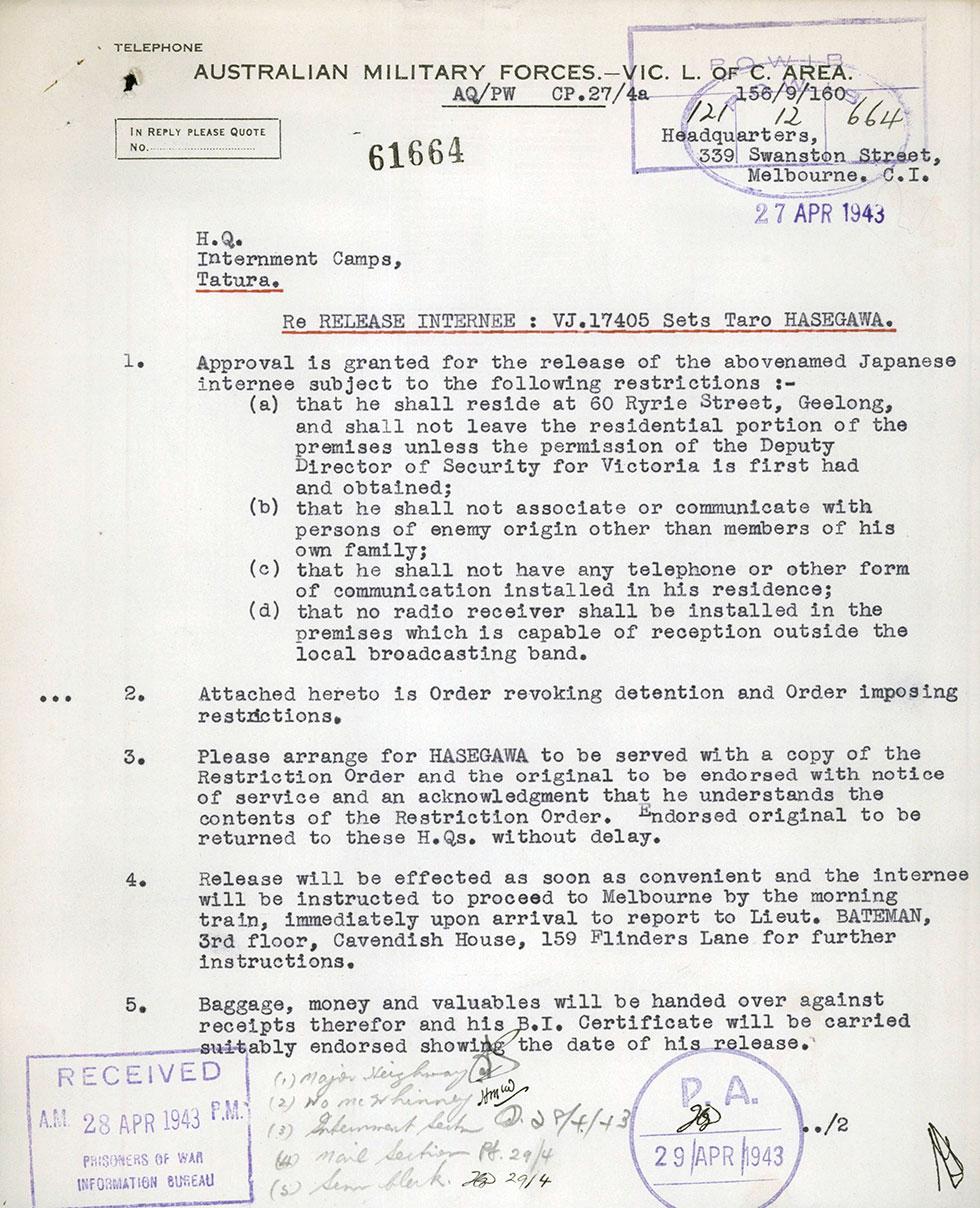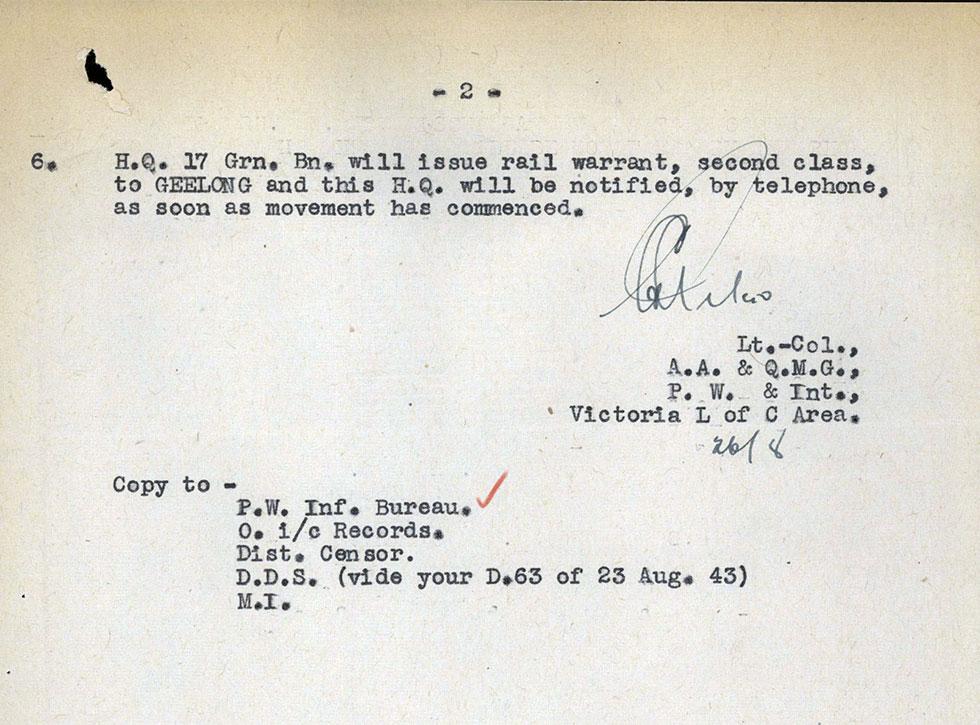

Aboriginal and Torres Strait Islander people should be aware that the National Archives' website and collection contain the names, images and voices of people who have died.
Some records include terms and views that are not appropriate today. They reflect the period in which they were created and are not the views of the National Archives.



[Page 1.]
TELEPHONE
[Header:] AUSTRALIAN MILITARY FORCES. – VIC. L. OF C. AREA.
[Underlined:] AQ/PW CP.27/4a
156/9/160
Headquarters,
339 Swanston Street,
Melbourne. C.I.
[Rectangular stamp, in faded purple ink reads ‘POWIB’ with a grid in the lower half of the stamp. Handwritten numbers are written in the grid. They read ‘121’, ‘12’, and ‘664’.]
[Oval stamp in faded purple ink overlaid across the rectangular stamp and typed address. Illegible.]
[stamped date reads:] 27 APR 1943
[rectangular box reads ‘IN REPLY PLEASE QUOTE NO.’]
[Stamp in black ink reads ‘61664’.]
H.Q.
Internment Camps,
[underlined in red ink] Tatura.
[underlined in red ink] Re RELEASE INTERNEE : VJ.17405 Sets Taro HASEGAWA.
1. Approval is granted for the release of the abovenamed Japanese internee subject to the following restrictions :-
(a) that he shall reside at 60 Ryrie Street, Geelong, and shall not leave the residential portion of the premises unless the permission of the Deputy Director of Security for Victoria is first had and obtained;
(b) that he shall not associate or communicate with persons of enemy origin other than members of his own family;
(c) that he shall not have any telephone or other form of communication installed in his residence;
(d) that no radio receiver shall be installed in the premises which is capable of reception outside the local broadcasting band.
. . .
2. Attached hereto is Order revoking detention and Order imposing restrictions.
3. Please arrange for HASEGAWA to be served with a copy of the Restriction Order and the original to be endorsed with notice of service and an acknowledgement that he understands the contents of the Restriction Order. Endorsed original to be returned to these H.Qs. without delay.
4. Release will be effected as soon as convenient and the internee will be instructed to proceed to Melbourne by the morning train, immediately upon arrival to report to Lieut. BATEMAN, 3rd floor, Cavendish House, 159 Flinders Lane for further instructions.
5. Baggage, money and valuables will be handed over against receipts therefor and his B.I. Certificate will be carried suitably endorsed showing the date of his release.
[Square stamp in purple ink reads ‘RECEIVED A.M. 28 APR 1943 P.M. PRISONERS OF WAR INFORMATION BUREAU’.]
[Handwritten notes in lead pencil read:] (1) Major [name and initials illegible.] (2) No me [name and initials illegible.] (3) Internment Section [initials illegible.] 28/4/43. (4) Mail section [initials illegible.] 29/4. (5) [illegible note and initials.] 29/4.
[circular stamp in faded purple ink reads ‘P.A. 29/APR/1943’ illegible handwritten initials written in black ink in centre of stamp.]
../2
[Page] - 2 –
6. H.Q. 17 Grn. Bn. will issue rail warrant, second class, to GEELONG and this H.Q. will be notified, by telephone, as soon as movement has commenced.
[handwritten signature, illegible.]
Lt.-Col.,
A.A. & Q.M.G.,
P.W. & Int.,
Victoria L of C Area.
[handwritten note reads ‘26/8’.]
Copy to –
P.W. Inf. Bureau. [handwritten tick in red pencil added.]
O. i/c Records.
Dist. Censor.
D.D.S. (vide your D.63 of 23 Aug. 43)
M.I.
This record is the release decision that allowed Japanese Australian Setsutaro Hasegawa to leave his internment at the Tatura camp. He was released on 3 May 1943 at the age of 73. Upon release, he was allowed to return to his residence in Geelong, but strict restrictions were applied to his movements.
Restrictions included that he ‘shall not leave the residential portion of the premises' (his home) and 'that he shall not associate with persons of enemy origin other than members of his own family'.
Setsutaro arrived in Australia in 1897, almost 45 years before his internment during the Second World War. He had applied for naturalisation (to become a citizen) in 1913 but was deemed ineligible based on his being 'a native of Asia', which was in line with the White Australia policy at the time.
Setsutaro originally appealed against his internment, but the decision of the tribunal was for his internment to continue. This decision was later reversed, as this record shows.
The decision to release Setsutaro before the end of the Second World War arose from concerns about his health, which was considered 'poor even taking into consideration his age of 73 years'. His 'good character, quiet and unassuming nature' was also used in his favour, leading to his release from internment in 1943.
Those who were released from internment were issued an 'Order revoking detention' that allowed them permission to leave the internment camp. Some Japanese internees, like Setsutaro, were then also issued an 'Order imposing restrictions.' These orders allowed them to return to their home to remain on the premises until further notice, effectively placing them under house arrest.
Unlike Setsutaro, most Japanese internees were repatriated upon release. This means that they were sent to Japan by the Australian government. This decision was made despite many having lived in Australia for decades without clear ties to the country of Japan.
Setsutaro Hasegawa still has descendants living in Australia today.
Think back to when you may have been subject to government restrictions, such as during the Covid-19 pandemic. What feelings and challenges did you face? How might these feelings and challenges have been similar – and different – to what Setsutaro Hasegawa experienced after he was released from internment?
Learn how to interpret primary sources, use our collection and more.
